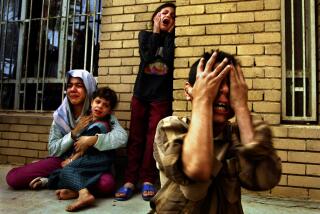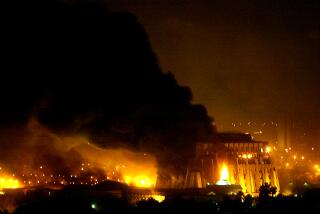Battle-Weary Iraqis Prepare for New Ordeal
- Share via
BAGHDAD, Iraq — The large black banners began appearing a few days ago at busy intersections throughout Baghdad, and, for most Iraqis, their message had an old yet painfully familiar ring.
They were official reminders of heroism, martyrdom and death. For a nation that has endured far too much of all three in the past decade, they were dark omens that yet another round of war may lie ahead.
“In the name of God, the most gracious, most merciful,” began one such banner on the wall outside the Baghdad Horsemanship Club compound in the Al Mansour neighborhood, “this is to honor the martyrdom of air force pilot Maj. Mohammed Abdulaziz Tabara, who died on Aug. 4 as he fought for the Islamic nation.”
Aug. 4, 1990, two days after Iraq’s invasion of Kuwait: a prelude to what may become another war.
Throughout Iraq’s brutal eight-year conflict with Iran, which ended just two years ago, the white-on-black banners were constant sights on Baghdad’s streets. But their reappearance this week in a nation so tightly controlled that official permission is required for every billboard and sign stands out as a stark symbol of how President Saddam Hussein is psychologically preparing his 17 million people for more war, more death, more sacrifice.
Beside the black martyrdom banner, there was another one in white that declared, “Iraq is trying to protect the holy places from the Americans and those who cooperate with them.”
They are much-needed messages, to be sure. In a nation where nearly every family has lost sons or fathers and tens of thousands more lost limbs, the memories of the war recently ended are as painful as an open wound.
Nobody knows how many died during those eight years of trench warfare, tank and artillery battles and missile barrages, although most estimates put the death toll as high as 1 million--nearly half of them Iraqis.
To the Western mind, the mere thought of yet another, far more catastrophic conflict with the many foreign armies and sophisticated air forces that the outside world has ranged around them would plunge such a nation into utter despair.
But the Iraqi mind is a thing apart. It is battle-weary, yet battle-hardened. It deeply mourns human loss, yet uses that sorrow to fight harder. It is a mind as tightly controlled as the society around it, constantly bombarded with Hussein’s slogans about Iraqi pride and nationalism. And it is a mind that he has conditioned to draw personal strength from the power of its president and its nation.
Just listen to Madria Nasser Abdul Mishadani, a 40-year-old teacher whose husband was injured nearly a dozen times while fighting in the Iran-Iraq War but kept returning to the front lines.
Approached at random by an American journalist in a Baghdad market on Monday, she was asked whether Iraqi women are nervous about the looming war.
“No women are afraid,” she said. “Aren’t we Iraqis? Why should we be scared of war?”
She added that the commitment is not merely a nationalist one. The cause is just, she said, and one worth fighting for, even if it means taking on the rest of the world.
“For 20 years, we’ve tried to get Kuwait,” she said with pride about the Aug. 2 invasion that started the Persian Gulf crisis. She justified Iraq’s occupation of the tiny gulf state by citing the U.S. invasion of Panama last year.
Nabeel Abyass, who was standing in a bread line several miles away, echoed that view. In fact, the 30-year-old employee of a Baghdad export-import firm, who fought in the front lines of the Iran-Iraq War from 1984 until it ended in 1988, described the Iraqi psyche by using the Arabic word that means “hardened in battle.”
“Why should I be afraid of war?” Abyass asked. “The people who are in the right aren’t afraid of fighting those who are wrong. Besides, we have the will to face the strongest country in the world.”
The bravado clearly is part of the way every Iraqi home gets psyched up each day in the current crisis. It is a joint effort, Abyass said. When he goes home at the end of each day, the nights are filled with talk of the crisis.
“Politics and work are our entire lives right now.”
But the biggest cheerleader of all is the president himself. He has built into Iraq’s Orwellian system a natural resilience and cult of the military that actually thrives in a war atmosphere, according to diplomats and analysts who have lived in Baghdad during times of both war and peace.
The prolonged war with Iran also gave Hussein distinct logistic advantages.
“Frankly, because of the war, the Iraqis have an enormous ability to organize things,” one European diplomat said.
And the fresh backdrop of war appears to have conditioned Iraqis to the concept of personal and physical sacrifice for the preservation of a nation long ruled by outsiders.
These are all traits that Hussein has taken pains to nurture and reinforce in his society, both to strengthen the nation amid the devastation of war and to justify the fight, no matter how obtuse the logic.
Baghdad, for example, is filled with government-commissioned statues and mammoth posters attesting to glorious victory in the war with Iran, in which Iraq gained little and then, just two weeks ago, gave up every piece of real estate it had captured.
Outside one government building is a statue of a giant Iraqi air force pilot standing amid the actual ruins of a crashed Iranian F-4 fighter jet. Officially, it is to commemorate an air force so proficient that it is said to have shot down 67 Iranian planes in a single day.
A guide from the Iraqi Cultural Ministry explained that the story behind the statue is of a dogfight between an Iraqi pilot, who was out of ammunition, and an Iranian jet close on his tail. The Iraqi is said to have looped around and deliberately crashed into the Iranian in a suicide maneuver that killed both.
But the best illustration of the unusual war psychosis that Hussein has bred into his people is the enormous Monument of Saddam’s Qadissiya Martyrs. It commemorates the war dead from the Iran-Iraq War, which the Iraqi president named Qadissiya II after a 7th Century battle in which Arabs defeated Persians.
The shrine sits in the center of a 600,000-square-yard park that includes a roller coaster and other amusement park rides. The monument, a glittering blue Islamic dome split into two pieces, stands 120 feet high and 440 feet wide. It weighs 2,130 tons, all pure marble covered in blue ceramic tile. It took 27 months to build between 1981 and 1983, which was the height of the war.
The cost of the monument: 40 million dinars, then the equivalent of nearly $100 million.
“It’s a fascinating reflection of Saddam Hussein’s priorities,” one Western diplomat in Baghdad said. “While most of the Arab leaders in the gulf have spent their vast oil wealth on opulent palaces, Gargantuan and abstract sculpture and municipal buildings or simply gambling in the casinos of London and Monte Carlo, Saddam has used it for things like this.
“In a way, of course, he has had to. He needs these huge symbols to convince his people of what he himself believes to be true. And he needs them to reinforce the notion that they must always be ready for war, that the sacrifice of war brings both glory and strength.”
Back in Baghdad’s bazaars, it would seem that Hussein’s policy of indoctrination has been all but complete.
Hicham Abdul Alim, a 30-year-old pharmacist waiting along with 29 others in one of the many bread lines caused by the world’s embargo of trade with Iraq, was asked whether some of his friends and neighbors were hoarding food to prepare for war, an offense punishable by death.
Alim, who is not a member of Hussein’s Arab Baath Socialist Party, said that he did know of several such offenders but that each time he learned of it, he would give them a simple speech he said was designed to prepare them for another round of sacrifice and war.
“You are a weak person,” he said in relating that speech to an American journalist Monday. “A strong person can feed himself on one loaf of bread, while a weak person can have 50 loaves of bread and still feel he doesn’t have enough.”
Then, Ahmad Abdallah, 54, who was standing nearby, was asked whether he had anything he wanted to say to the American government, which is leading the boycott that has forced him to wait each day for flour and bread.
“I want to tell the American people that our president wants peace,” he said. “I’m sure the American people want peace, but Bush wants to keep causing problems. . . . This is a fight between presidents.”
But then, Abdallah added that he and his countrymen are more than prepared for an all-out war.
“We have experienced war for the last decade,” he said. “And we are ready to fight until the last person.”
More to Read
Sign up for Essential California
The most important California stories and recommendations in your inbox every morning.
You may occasionally receive promotional content from the Los Angeles Times.










